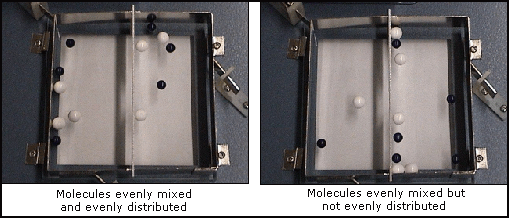The Molecular Motion Demonstrator (MMD) shows how the random motion of molecules in a gas causes two separate gases to diffuse.
WATCH THE VIDEO
Teachable Topics:
- molecular motion
- particle transport
- chemical potential
Theory:
Two gases will mix into one another because of the random motion of molecules. Such mixing is called diffusion (not to be confused with convection, where large-scale currents mix gases together).
Two gases separated by a barrier with a hole will mix by passing through the hole. This can be represented with the MMD by using a metal barrier with a hole to partition MMD. Putting small blue beads on one side and large beads on the other represents having two different gases initially separated by a barrier. Eventually, the random "molecular motion" created by the MMD will cause some "molecules" to pass through the barrier and mix with the other molecules.

Figure 1: Molecules experiencing diffusion
This experiment begins with all small molecules on one side and all large molecules on the other side.
After some time, the molecules are mixed together, and both sides probably contain some large and some small molecules. There is nothing to keep like-sized molecules together, and the two sides of the barrier are identical.
At a given moment, then, one side may contain more molecules than the other, or may have a higher concentration of one kind of molecule than the other. On the average, though, the molecules are evenly distributed between the two sides, and the two kinds of molecules are evenly mixed with one another.
If more beads were used in the experiment, these kind of fluctuations wouldn't occur so drastically. In a real, macroscopic gas, where there are countless molecules, any fluctuations are so relatively small that they aren't noticed. This means that two gasses diffusing into one another will stay mixed, and will appear totally uniform in composition.
Apparatus:
- Molecular Motion Demonstrator
- aluminum barrier with hole
- six blue beads
- six white beads
Procedure:
- Set up the Molecular Motion Demonstrator on a flat surface or on an overhead projector.
- Next, add the aluminum barrier to the frame.
- Place in six blue beads on one side of the barrier, and six white beads on the other side of the barrier.
- Turn on the MMD, and adjust the speed to a level that makes the beads diffuse through the barrier.



